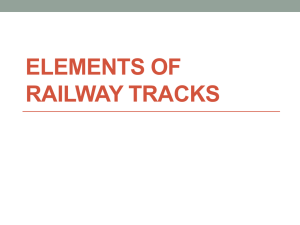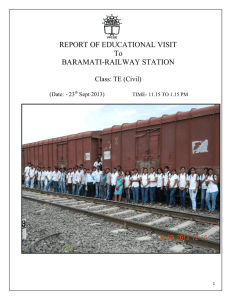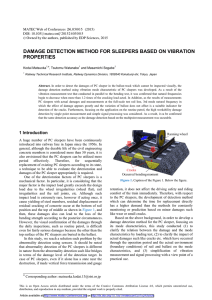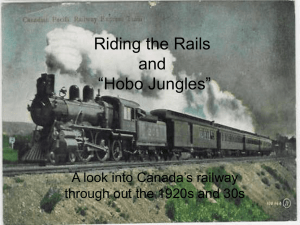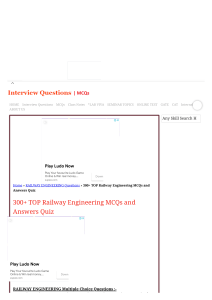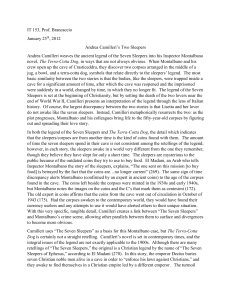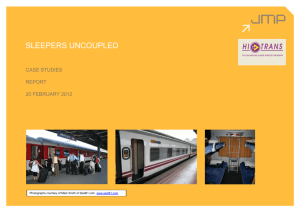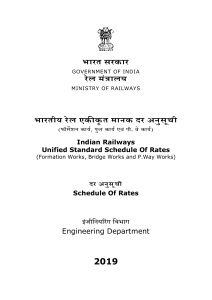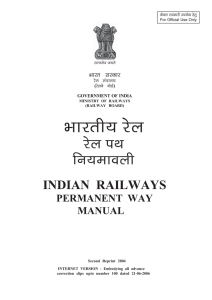Rail Gauges The gauge of a rail track is defined as the
advertisement
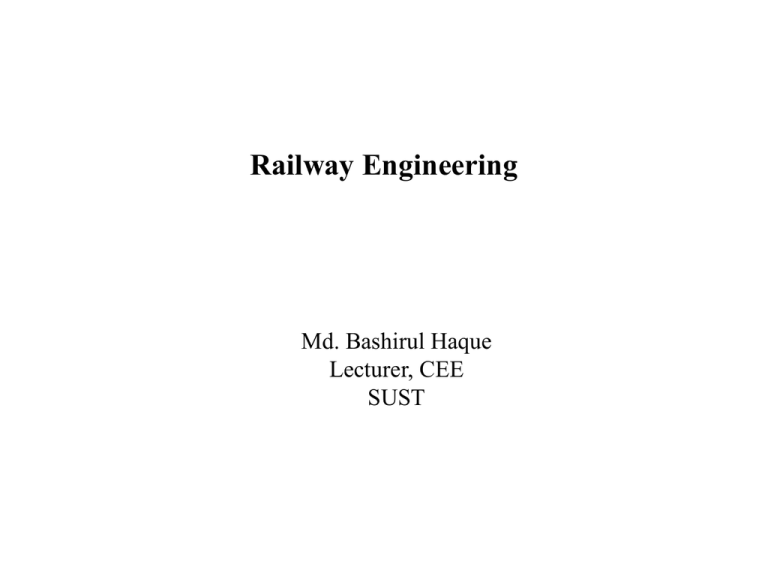
Railway Engineering Md. Bashirul Haque Lecturer, CEE SUST Cross Section of a Rail Line Ballast Rail Gauges The gauge of a rail track is defined as the clear minimum perpendicular distance between inner faces of the two rails. Types of gauge: • Broad gauge: width:1524mm to 1676 mm or 5’-6” to 5’-0’’ • Standard gauge: width: 1435 mm ,1451 mm or 4’-8.5’’ , 4’-9.125’’ • Meter gauge: width: 1000 mm , 1067 mm, 915 mm or 3’-6’’, 3’-3.375’’ and 3’-0’’ • Narrow gauge: width: 762 mm , 610 mm or 2’-6” and 2’-0” Rail Definition: Rail is similar to steel girders. These are placed end to end to provide continuous and level surface for the trains to move Functions of Rail: • To provide continuous and level surface for movement of train. • To provide a mooth pathway so that friction between rail and wheel become less. • Serve as a lateral guide for the running of wheels. • Transferring the load into the sleeper. Types of rails: 1. Double headed rails 2. Bull headed rails 3. Flat footed rails Components of an ideal rail section: Sleepers Definition: Sleepers are transverse ties on which the rails are laid. Functions of sleepers: • Holdings rails to correct gauge and alignment. • Giving a firm and even support to rails. • To maintain the alignment and gauge of the track correctly. • Transferring the load evenly from the rails to wider area of the ballast. • Acting as an elastic medium between the rails and the ballast to absorb the blows and vibrations of moving loads. • Providing lateral and longitudinal stability of permanent way. Types of sleeper: Depending upon the material sleeper can be classified as: • • • • Wooden sleeper Steel sleeper Cast Iron sleeper Concrete sleeper Wooden Sleepers: Advantages: • Cheap & easy to manufacture. • Absorb shock & has got good capacity to dampen the vibrations. • Thereby retains packing well. • Easy handling without damages. • Suitable for track circuited sections. • Alignment can be easily corrected. • Can be used with or without stone ballast. Disadvantages: • Lesser life due to wear, decay & attack by vermin. • Liable to mechanical wear with better packing. • Difficulty to maintain gauge. • Susceptible to fire. • Scrap value is negligible. Steel Sleepers: Advantages: • Long life. • Easy to maintain gauge & lesser maintenance problem. • Better lateral rigidity. • Lesser damage during handling & transportation. • Manufacturing process is simple. • Very good scrap value. • Free from decay & attack by vermin. • Not Susceptible to fire hazard. Disadvantages: • Liable to corrosion. • Unsuitable for track circuiting areas. • Develops cracks at rail seats during service. • Can only be used for rails for which it is manufactured. Cast Iron Sleeper: Advantage: • Lesser corrosion. • Lesser liable to crack at all rail seats. • Easier to manufacture. • High scrap value. Disadvantage: • Provide lesser lateral stability. • Unsuitable for track circuited lines. • Not very suitable for mechanical maintenance. • More susceptible to breakage. Concrete Sleepers: Advantages: • Retain packing well. • Concrete sleepers can be used in track circuited areas, • Neither inflammable nor subjected to damage by corrosion. • The life of concrete sleeper is very long, probably 40 to 50 years. • Can be made by local resources. • Manufacturing process is simple. Disadvantages: • The damages to concrete sleepers are very heavy at the time of derailment. • There is no scrap value for the concrete sleepers. • Damage at the time of handling and transportation Ballast Definition Ballast is a layer of broken stone, gravel or any other granular material placed and packed below and around sleepers for distributing the load from the sleepers to the formation and for providing drainage as well as given longitudinal and lateral stability of the truck. Functions of ballast:• To provide a level and sound foundation for the sleepers to rest on. • To hold the sleepers in position during the passage of trains. • To transfer and distribute the load from sleepers to the large area of formation. • To provide elasticity and resilience to track for getting proper riding comfort. • To provide necessary resistance to track for longitudinal and lateral stability. • To provide effective drainage to track and keep the sleepers in dry condition. Types of ballast: Following materials are used as ballast in a railway track • Broken stone • Gravel • Coarse sand • Kankar • Brickbats • Selected earth Railway station Purpose of a railway station: A railway station is provided for one or more of the following purposes • To entrain or detrain the passengers • To load or off load the goods or parcels • To control the movement of trains • To enable the train to cross each other in case of single line section • To enable the faster trains to overtake the slower trains • To enable the locomotives to take fuel water or coal • To attach or detach coaches or wagons to the train • To provide facilities for change of engines and crew/staff. Classification of station as per functional consideration: • • • • • Halts Flag stations Road side or crossing stations Junction stations Terminal stations
